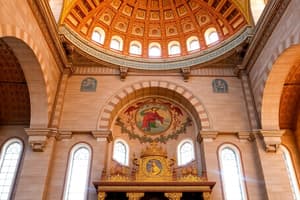Podcast
Questions and Answers
What is the purpose of the bema in early Christian churches?
What is the purpose of the bema in early Christian churches?
- It serves as the main entrance to the church.
- It is a raised platform for the altar. (correct)
- It functions as a pulpit for preaching.
- It is an area for congregational seating.
What distinguishes a major basilica from a minor basilica?
What distinguishes a major basilica from a minor basilica?
- Major basilicas must be granted privileges by the pope. (correct)
- Major basilicas have more historical significance.
- Minor basilicas are often built in urban areas.
- Minor basilicas are usually larger than major basilicas.
In the floor plan of an early Christian basilica, where is the choir typically located?
In the floor plan of an early Christian basilica, where is the choir typically located?
- Within the atrium
- Adjacent to the altar
- Enclosed by the cancelli (correct)
- At the entrance of the church
Which area is described as the space where baptism takes place?
Which area is described as the space where baptism takes place?
Which of the following best describes the purpose of the altar in a Christian church?
Which of the following best describes the purpose of the altar in a Christian church?
What is the architectural significance of the atrium in early Christian churches?
What is the architectural significance of the atrium in early Christian churches?
What function does the narthex serve in early Christian architecture?
What function does the narthex serve in early Christian architecture?
What was one significant effect of the rise of Christianity on Roman architecture?
What was one significant effect of the rise of Christianity on Roman architecture?
Which structure is commonly associated with the term 'ambo' in Christian churches?
Which structure is commonly associated with the term 'ambo' in Christian churches?
In what way did the geographical position of Rome impact its architectural influence?
In what way did the geographical position of Rome impact its architectural influence?
Which feature is characteristic of a basilican church?
Which feature is characteristic of a basilican church?
What was a key factor contributing to the rise of Christianity as the established religion in the Roman Empire?
What was a key factor contributing to the rise of Christianity as the established religion in the Roman Empire?
How did geological factors influence the design of early Christian churches?
How did geological factors influence the design of early Christian churches?
Which component of a basilica is primarily designated for the clergy?
Which component of a basilica is primarily designated for the clergy?
What was a major change in the Roman political system during Constantine's reign?
What was a major change in the Roman political system during Constantine's reign?
What is indicated by the statement 'all roads lead to Rome' in the context of its empire?
What is indicated by the statement 'all roads lead to Rome' in the context of its empire?
Flashcards are hidden until you start studying
Study Notes
Influences on Early Christian Architecture
- Rome's geographical position as a key center led to the saying, "All roads lead to Rome."
- The capital's growth in Christianity contributed to its status as a universal faith.
- Architectural styles were shaped by the reuse of materials from Roman ruins, specifically columns and decorative marbles in new basilican churches.
Climate and Religion
- Roman architectural characteristics are mirrored in the climate, influencing design elements.
- Christianity's rapid expansion was facilitated by Constantine's decree in Milan, granting equal rights to Christianity, which ultimately became the state religion.
Social and Political Context
- The capital of the Roman Empire was moved from Rome to Byzantium, transitioning the political structure.
- Constantine reigned as an absolute monarch, marking the end of the traditional Roman political system.
Historical Overview
- The early Christian period spanned from AD 300 to 604, with the cessation of earlier Roman artistic styles.
- Following this period, European architecture saw stagnation as old Roman styles were largely replaced by Romanesque architecture.
Architectural Examples
- Significant structures include basilican churches, baptisteries, and tombs, representing the final phase of Roman architecture.
- Christianity's status as the state religion influenced the design of house-churches and larger ecclesiastical buildings.
Characteristics of Basilican Churches
- The Roman basilica form served as the foundation for church designs, featuring a rectangular plan with a central nave and side aisles.
- Basilican churches were often built over the burial sites of saints, with facades oriented eastward.
Structural Elements of a Basilica (San Clemente, Rome)
- Nave: Central aisle running from the entrance to the altar area.
- Aisle: Longitudinal divisions flanking the nave, separated by columns or piers.
- Apse: Semi-circular sanctuary projection at the building's east end.
- Tribune: Recess where the bishop's throne is situated.
- Bema: Space in front of the apse supporting clergy functions.
- Sanctuary: Sacred area housing the principal altar.
- Altar: Table for the Eucharist and communion ceremonies.
- Atrium: Forecourt surrounded by porticoes, often with a covered walkway.
- Narthex: Vestibule for penitents before entering the main church.
Floor Plan Components
- Includes one apse, tribune, bema, various aisles, a choir, and other specific areas designated for clergy and ceremonies.
Old St. Peter's and Its Layout
- Featured fundamental areas such as the apse, transept, nave, and a prominent narthex and atrium alongside the tombs of early saints.
Baptistery of Ravenna
- An octagonal structure known for its exquisite mosaics that depict the baptism of Christ, serving as a dedicated space for baptisms.
Types of Basilicas
- Major Basilicas: Highest papal ranking churches, including St. Peter's Basilica and Basilica of St. Paul Outside the Walls.
- Minor Basilicas: Churches recognized for historical and architectural significance, including those in the Philippines.
Noteworthy Minor Basilicas
- Thirteen minor basilicas exist in the Philippines as of 2015, highlighting the global influence of Roman Catholic architecture.
Studying That Suits You
Use AI to generate personalized quizzes and flashcards to suit your learning preferences.




